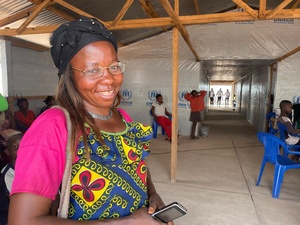Angola: Tripartite meeting discusses slow pace of return from Zambia
Angola: Tripartite meeting discusses slow pace of return from Zambia
The pace of returns in our voluntary repatriation programme to assist Angolan refugees from Zambia back home is proving slower than originally hoped because of continued problems of poor access by road, both from Zambia to Angola, and within the country. Angolan roads are in bad condition, bridges are broken and there are problems with landmines.
UNHCR started its second season of voluntary repatriation of Angolan refugees from Zambia in mid-June and we had expected to assist some 40,000 refugees to return by November when the rainy season starts in earnest. However, so far only 8,354 refugees have been able to return by the two land and two air corridors. At the beginning of the repatriation season this year 71,420 Angolan refugees were living in camps and settlements in Zambia.
The two air corridors to Angola from Zambia that opened up this year are helping to boost numbers of returns to areas inaccessible by road. An airlift started in mid-August in conjunction with IOM [International Organization for Migration] from Mongu to Lumbala N'Guimbo in the east of the country, and in early September another air route from Mongu to Huambo in the central plateau opened. IOM said it could transport up to 20,500 refugees home by airlifts but runway conditions in Lumbala Nguimbo, once the heavy rain starts may bring the airlift to a grinding halt. Currently only one plane is operating the airlift and UNHCR is working with IOM to charter a second aircraft.
These issues are being discussed at a tripartite meeting currently taking place in Lusaka between the Zambian and Angolan governments and UNHCR.
Overall, 20,421 Angolan refugees sheltering in neighbouring countries have returned home this year on UNHCR organised convoys - from DRC [the Democratic Republic of the Congo] (9,906), Zambia (8,354) and Namibia (2,161). Since the repatriation programme started last year more than 100,000 Angolans assisted by UNHCR have returned home.
Next week we hope to start an airlift of refugees from Namibia to Huambo, and soon open another land corridor from the DRC into Uige province in the north of Angola.
At the time the peace accords were signed in April 2002, about 441,000 Angolan refugees were estimated to be living in bordering countries. Since then an estimated 250,000 have returned home. UNHCR estimates some 200,000 Angolan refugees currently remain in the major asylum countries - DRC, Zambia, Namibia and Republic of Congo, in addition to 14,000 in South Africa and Botswana.









